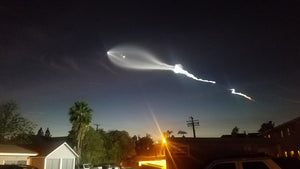August- Perseid Meteors, Antares Occultation, and M27
Perseid Meteor Shower
The Perseids meteor shower peak is highly anticipated this year due to favorable dark sky conditions. The Moon, appearing as a waning crescent won't cast much light, giving us great observation opportunities. The peak of the meteor shower is projected to be between 3 AM ET (Midnight PT) and 10 AM ET (7 AM PT) on the morning of the 13th. You can start your meteor watch on the evening of the 12th, but you’ll have a much better chance if you wait until after midnight.
Look towards the eastern and northern horizons or to the radiant in the constellation Perseus which rises around 1AM. Under perfect conditions the Perseids can produce up to 100 meteors per hour. This year, in a dark location, we can expect anywhere from 50 to 90 meteors per hour. Enjoy the show!
Occultation of Antares
Visible in most of the central and eastern regions of the United States, an exciting celestial event will take place on the evening of the 24th. During this time, the first quarter Moon will perform an occultation, meaning it will pass in front of and temporarily cover Antares, the brilliant star in the constellation Scorpius. While the precise timing and duration of this phenomenon will differ depending on one's location, on a global scale, the occultation is set to commence at 21:20 ET and conclude at 23:39 ET. This rare spectacle offers an excellent opportunity for skywatchers to witness the Moon gracefully masking one of the night sky's most prominent stars. Be sure to mark your calendars and find a suitable vantage point to observe this awesome event on the 24th.

Dumbbell Nebula (M27)
Messier 27, better known as the Dumbbell Nebula. This celestial gem holds a special place in the night sky, standing as the second brightest planetary nebula after the Helix Nebula in Aquarius. What sets it apart is its remarkable surface brightness, making it a favorite among stargazers due to its ease of observation and detection.
Planetary nebulae like the Dumbbell Nebula provide us with a captivating glimpse into the cosmic destiny of our very own Sun. As our Sun nears the end of its life cycle, it will transform into a planetary nebula, just like Messier 27. Picture giant stars evolving and gracefully shedding their outer layers, exposing their hot cores, and emitting dazzling ultraviolet light that ionizes the surrounding expelled material. The result is a mesmerizing spectacle as the clouds expand and gracefully disperse into the vastness of space.
First observed by the esteemed Charles Messier on July 12, 1764, the Dumbbell Nebula earned its name for its unique two-lobed appearance. Even when observed through larger telescopes, it presents a captivating white glow. Yet, for those seeking to delve deeper into its celestial secrets, the fine details of this nebula come to life through the lens of color astrophotography.
In essence, the Dumbbell Nebula invites us to marvel at the grand cosmic ballet of creation and transformation. It serves as a constant reminder that the universe is a canvas of endless beauty and mystery. So, as we peer through the telescopes of knowledge, let us appreciate the wonders of Messier 27 and be inspired to explore the boundless frontiers of our cosmic home.







